Recent Twilight Time releases
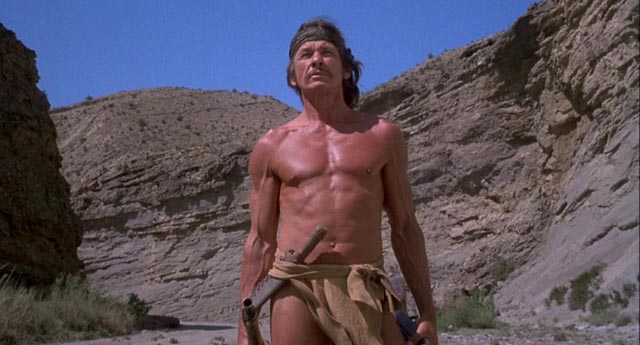
Twilight Time continues to release an eclectic selection of titles … too many, unfortunately, to keep up with. One of the best things about a small company like this is that it’s characterized by the idiosyncratic tastes of the people who run it. My most recent Twilight viewing reflects this, with a thriller maligned on its initial release (it had been taken out of its director’s hands and re-edited by the producers), a harsh western directed by an Englishman in Spain, and a sprawling Hollywood epic which was one of the last of the big ’60s roadshow productions.
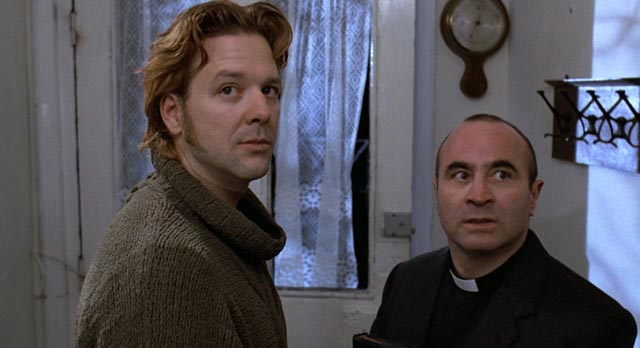
A Prayer for the Dying (Mike Hodges, 1987)
Mike Hodges is one of those filmmakers who, perhaps unfortunately, began his theatrical career with a masterpiece. After working for several years on English television dramas, he wrote and directed what remains, forty-five years later, perhaps the greatest of British gangster movies: Get Carter (1971). Where do you go when you start at the very top? Hodges became very self-conscious, following Carter up with the comedy-thriller Pulp (1972), the slick and empty Michael Crichton adaptation The Terminal Man (1974), and the overblown camp of Dino De Laurentiis’ Flash Gordon (1980). After some more television work, he pretty much hit bottom with Morons from Outer Space (1985) before making a serious bid to regain the high ground he’d staked out with Get Carter.
A Prayer for the Dying (1987) was adapted from a novel by Jack Higgins (best known for The Eagle Has Landed). It opens with a devastatingly effective prologue in which several members of the IRA set up an ambush for a British patrol in the lush Irish countryside, only to see things go wrong when a bus full of schoolchildren arrives on the scene ahead of the Army vehicles. Martin Fallon (Mickey Rourke) is unable to brush off this “accident”, a crisis of conscience sending him underground in England, sought by both the British authorities and his former comrades who now view him as a traitor.
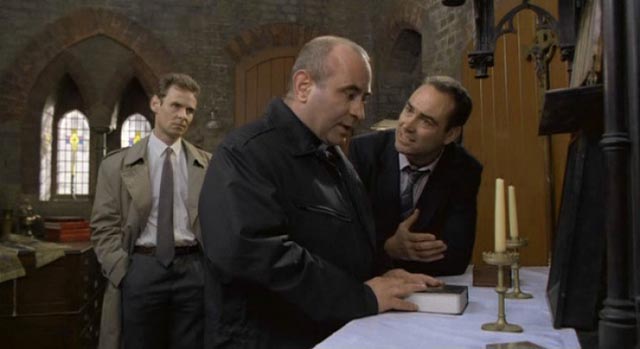
In a sense, this is an urban western with a flawed hero trying to escape his violent past only to find himself dragged back into the world he now hates. Blackmailed by Jack Meehan (Alan Bates), a repulsive gangster who uses a funeral home for a front, Fallon reluctantly assassinates a rival gangster in a churchyard, his act witnessed by the priest, Father Michael (Bob Hoskins). Fallon violates the “rules” by not killing this witness; instead, to protect himself, he uses the confessional to openly admit his guilt, thus binding the priest to silence.
The story has multiple strands – Fallon’s attempts to escape the country; Father Michael’s efforts to get him to turn himself in and find redemption; Meehan’s desire to eliminate Fallon as a risk to his business; and his former IRA buddies (Liam Neeson and Alison Doody) closing in, either to get him back to Ireland or kill him. To complicate things, Fallon finds himself drawn to Father Michael’s blind niece (Sammi Davis), who naturally “sees” his inner goodness. All of this sounds strained, cliched and bordering on the ridiculous, but Hodges directs with assurance and the cast is excellent.
But then there’s that issue of it not being the director’s film. By the mid-’80s, this kind of behind-the-scenes bad publicity tended to colour critics’ responses. Here was evidence that an artist’s work was being mutilated by Philistines, and the more awkward elements of the film (say, Father Michael being a former SAS man who, like Fallon, is struggling with his own violent past) were blamed on this interference – to some degree with validity as the producers’ intentions were to make it into a more conventional action film rather than a meditation on guilt and redemption.
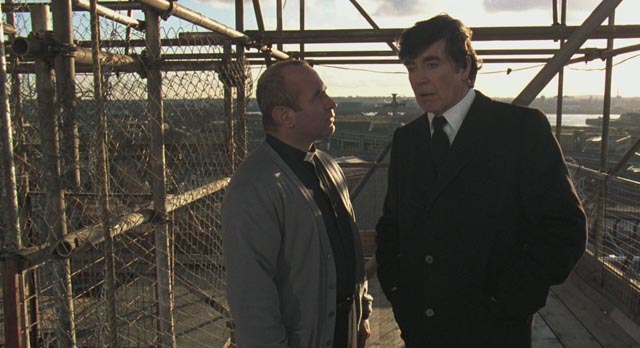
It’s refreshing, then, to hear Hodges in the lengthy interview included on the disk pointing out that ultimately his disagreement with the producers was a matter of emphasis; that he in fact shot everything that can be seen in the film and that he feels it’s pretty good as it is, even if it’s not exactly what he wanted. After all, this was a job for hire, not a project he himself initiated. He has an equable view of the business and the limitations it places on a filmmaker. And the fact is, with that cast all giving fully committed performances, particularly Rourke who was never better than here, and with Michael Garfath’s rich, noirish photography, A Prayer for the Dying rises above the weaknesses inherent in the material and emerges as a tight, atmospheric thriller which explores its themes quite effectively.
Although it ultimately doesn’t achieve the raw power of Get Carter, it deserves a much better reputation than it has and Twilight Time has done an excellent job of presenting it on Blu-ray, supplemented with that half-hour interview with Hodges and a shorter interview with cinematographer Garfath about his working relationship with the director.
*
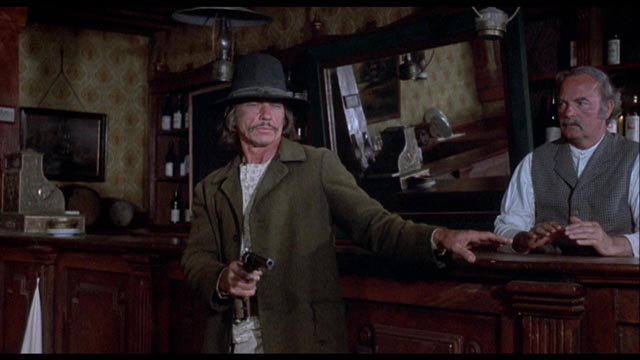
Chato’s Land (Michael Winner, 1972)
The folks at Twilight Time continue their project of trying to redeem the reputation of Michael Winner with their release of his second western, Chato’s Land (1972). Given the very English nature of Winner’s early work, it seems odd that when he made his way to the U.S., he should have first tackled the western: Lawman (1971) was somewhat typical of its period, using the genre to dissect the darker side of the American myth. It even benefited from a classical western cast, with Burt Lancaster, Robert Ryan, Lee J. Cobb and a huge number of familiar character actors. After an idiosyncratic diversion with The Nightcomers (also 1971), Winner collaborated again with his Lawman scriptwriter on another western the following year.
Chato’s Land was writer Gerald Wilson’s deliberately revisionist tale of race conflict on the frontier; some critics at the time easily spotted the film’s relevance to the Vietnam war. Pushed into a gunfight by a racist sheriff, the half-Apache Chato (Charles Bronson) defends himself, killing the lawman. Led by Quincy Whitmore (Jack Palance), a former Confederate officer, the local men quickly form a posse, seeing the pursuit and inevitable hanging of Chato as an amusing diversion. Whitmore very quickly comes into conflict with the aggressively racist Jubal Hooker (Simon Oakland) and his brothers Elias (Ralph Waite, very far from Walton Mountain) and Earl (Richard Jordan). The rest of the band is made up of an assortment of types, including Whitmore’s old friend Joshua (James Whitmore) and a couple of recent settlers (Roddy McMillan and Paul Young) who go along because they don’t want to risk offending their neighbours, even though they don’t believe in what they’re doing.
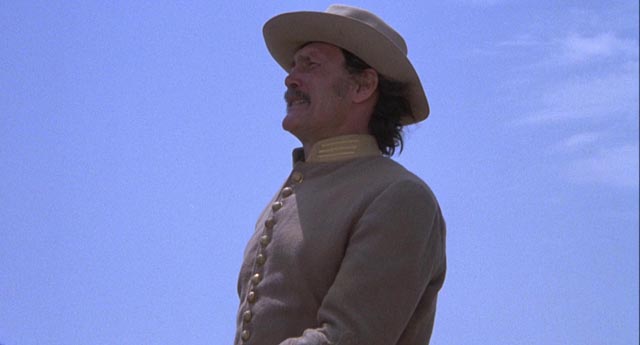
Chato, a mostly silent character who we seldom see as he first eludes the posse and then eventually begins stalking them, takes on a mythic quality. He is part of the landscape, as little understood by the white men as the desert itself. The film spends most of its time with the posse – and few westerns have ever presented such a talky bunch, bickering, joking, getting on each others’ nerves as the hunt begins to drag on, their bloodsport failing to materialize as quickly as expected. This is the grating arrogance of manifest destiny, driven by a certainty of righteousness which justifies them in the most horrific acts. But the hostile land wears them down, scraping off what thin veneer of civilized behaviour they might have possessed in town.
Chato does everything he can to dissuade them – driving off their horses, destroying their water supply – but they can’t admit the possibility that he might be more skilled than them in the desert. It’s only after they find and rape his wife that he gets serious about dealing with them. And even then, his strategy is essentially to provoke them into destroying themselves, something their anger and stupidity only too easily facilitates.
Chato’s Land is a revenge fantasy in which the plains Indians get to see the white invaders lose their illusion of power and die one by one. But like all such fantasies, the final note of bleak triumph is undercut by an awareness that this minor success is only a small bump on the way to the ultimate victory of the oppressors. Chato wins the round, but history shows that he will lose the war.
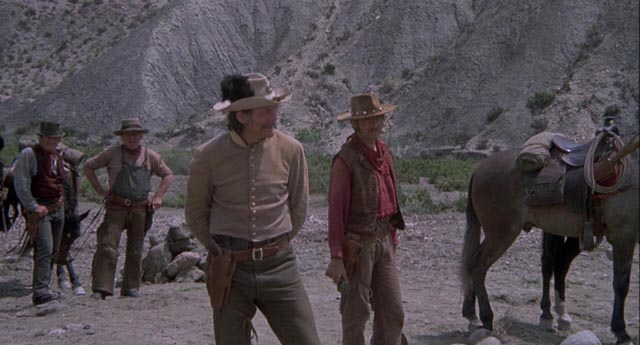
As with all of Winner’s best work, the film is really well cast. Bronson, who speaks only a handful of words and spends most of the movie in little more than a loincloth, presents a mythic image. This was the big step which propelled him towards the box office stardom of The Mechanic and Death Wish. Interestingly, he barely interacts with the rest of the cast, always set off at a distance. Jack Palance gives one of his most effectively restrained performances as Quincy, a man who has lost much (including the status he once had as a Confederate officer) and grasps briefly at this chance to lead again, only to find that he has no real power against the brute viciousness of the Hookers; and yet in being displaced by them, he manages to attain a kind of dignity before the end.
Gerald Wilson, in an interview recorded for the disk, talks about his thematic intentions and, with a touch of amusement, says that he wasn’t sure whether Winner actually understood the script. Perhaps there were things that the rather decadent Englishman didn’t get, but Winner gives the film visual and dramatic coherence, obviously taking pleasure in his actors, allowing them to fill lengthy moments with their chatter. Perhaps most interestingly, he found locations (mostly in Andalucia, Spain, with some extra shooting in Sonora, Mexico) which are devoid of the majestic beauty we see in the movies of John Ford or Sergio Leone; the land inhabited by Chato and invaded by the posse is harsh, dry, rocky and mostly pretty ugly, making the white men’s desire to steal it a pointed illustration of their greed and arrogance. In their eyes, there’s nothing here, but they want it anyway and to get it they’re willing to wipe out whatever inhabitants dwell there.
Winner’s long-time cinematographer Robert Paynter avoids pretty landscapes, leaving Bronson’s body to supply the film’s aesthetic pleasure. Of course, this treatment of the Indian as a mythic, almost supernatural force rising from the land is problematic in itself, in its way as dehumanizing as the traditional western’s depiction of “savages”, but ultimately Chato’s Land is about the self-destructive stupidity of the white settlers, a theme which applies in a larger sense to western society in general with its arrogant certainty that the world exists only for its own benefit.
*
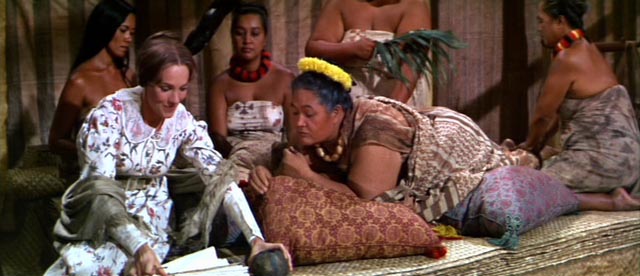
Hawaii (George Roy Hill, 1966)
Perhaps it’s just that I watched the two films almost back-to-back, but it seems to me that there are striking thematic similarities between Winner’s scrappy western and George Roy Hill’s sprawling historical epic, Hawaii (1966), based on the even more sprawling bestselling novel by James A. Michener. Although Hill’s career was highly eclectic in terms of genres, Hawaii is perhaps the least expected of all his films, its sheer scale threatening to overwhelm his usual focus on character. He was an odd choice for the job; having just made two theatrical adaptations and the charming coming-of-age comedy The World of Henry Orient in the previous three years, there was little indication that he was suited to a production of this size. Having never seen the film before, my vague impression was that it had been something of a misfire.
But my limited expectations just made it that much more impressive when I finally did watch it on Twilight Time’s Blu-ray. Although these kinds of historical epics were already beginning to seem passé by 1966, with Hollywood studios collapsing and producers scrambling to find ways to attract a younger, much less conservative audience, producer Walter Mirisch, writers Daniel Taradash and Dalton Trumbo, and director Hill somehow went against the grain here. Against the lush and exotic backdrop of the islands, they tell a very dark story of a clash between cultures … of the matriarchal Hawaiian islanders being colonized and ultimately destroyed by arrogant white invaders driven by the blind certainty of a superiority rooted in the grim rigidity of Calvinism. Unlike Winner’s film, however, Hawaii doesn’t mythologize the native culture; although it no doubt empathizes with it, the film doesn’t shy away from darker aspects, particularly the almost casual way in which the Hawaiians kill babies they deem defective in some way.
The adaptation takes the section of Michener’s 1000-year narrative which deals with fervent missionaries sent from the stiff and humourless society of New England to “save” the godless natives of Hawaii. But these men are no selflessly dedicated helpers; their mission is to break apart the native beliefs and customs in order to replace them with a relentless sense of guilt and shame designed to make them subservient and controllable – or as the missionaries themselves put it, to “bring the savages into the light of God.” Ironically, this group have come at the invitation of Prince Keoki (Manu Tupou), son of the Ali’i Nui, matriarchal ruler of one of the islands. In a stirring speech which opens the film, Keoki berates the newly graduated missionaries-to-be at Yale that white sailors and merchants have brought nothing but depredation to his society while promising God’s redemption. Having himself studied for four years at the college, he pleads with them to come and help by establishing stability and dignity with their God.
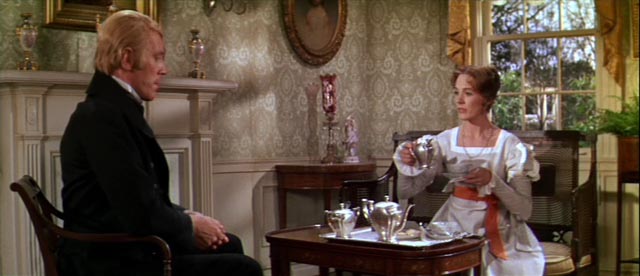
Among those who hear his call are the film’s protagonist, the Reverend Abner Hale (Max von Sydow), who turns out to be the most fanatical and self-righteous of the missionaries. Utterly blind to his own faults (arrogance and an overwhelming sense of pride in his personal connection with God), he furiously sets about “fixing” the faults of the Hawaiians. Unable and unwilling to see any value in their culture and their harmonious existence in this landscape, his unshakable purpose is to force them into a sense of shame. Lacking any diplomacy, he rampages through the community, berating and insulting their every belief and practice.
But his arrogance runs headlong into the firm, sometimes amused equanimity of the Ali’i Nui, Malama Kanakoa (Jocelyne LaGarde), who is curious about the outside world and eager to learn its ways. When the missionaries arrive, she immediately responds to the women among them, the wives brought along to protect the preachers against the temptations of the islands; in particular, she takes to Jerusha (Julie Andrews), the young woman Hale awkwardly courted and then married in order to receive his posting. Malama puts up with Hale only because she values Jerusha, who is immediately put to work teaching her how to write in English, a task made necessary by her need to write to the American president to request protection from the exploiters who prey on her people.
She is also interested in learning about Christianity, although it becomes clear that her intention is to incorporate this new god into the Hawaiian pantheon rather than have him replace the old gods. Hale’s blunt intolerance alienates those around him – eventually even Jerusha – but his unshakable certainty does undermine Malama’s own settled view of life, particularly in the matter of her marriage to her beloved husband Telolo (Ted Nobriga), who happens to also be her brother. Hale is determined to end this sin and to prevent the future marriage of Keoki, Malama and Telolo’s son, to his sister Noelani (Elizabth Logue).
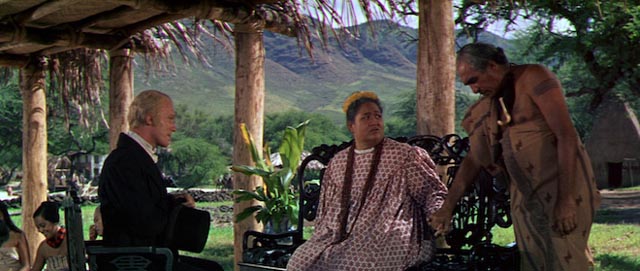
While others among the missionaries gradually come to some accommodation with the local society, one even marrying a local woman after his American wife dies (resulting in his expulsion from the community), Hale becomes more rigid and demanding. Finally, after Malama dies and Keoki, realizing that Hale holds him in contempt for being less than white, marries Noelani in order to carry on the sacred traditions of his native religion, Hale angrily calls down the wrath of his vengeful God to utterly destroy the Hawaiians. First, Noelani gives birth to a deformed child, which Hale declares is God’s punishment for their sin; then the island is ravaged by an epidemic of measles, against which the natives have no natural defence. It seems that Hale’s God has answered his angry prayer, and Jerusha declares that she no longer believes, that a God who could not see the essential decency of these people isn’t worthy of respect.
Hawaii deals in quite subtle ways with the mutual impact these two cultures have on each other, but even if some of the Americans eventually adapt to island ways, the imbalance is unavoidable. By the time personal tragedy finally cracks Hale’s arrogant certainty, teaching him a degree of humility which perhaps will finally enable him to help instead of trying to control the Hawaiians, the local culture has been irrevocably altered. More than half have died out, the remainder subsumed under the growth of commercial exploitation; even the missionaries develop sugar plantations, exploiting native labour to make money as their reward for their years of “sacrifice” in this place. Rejected by his own church, the ageing Hale is determined to fight for the Hawaiians’ rights. He has finally found the humility he previously lacked, but he has little power and the ending evokes a deep sense of melancholy. This is the story of the fall from grace in Eden, but it’s the Christian fanatics who fill the role of the serpent and it’s the islanders who have lost their innocence.
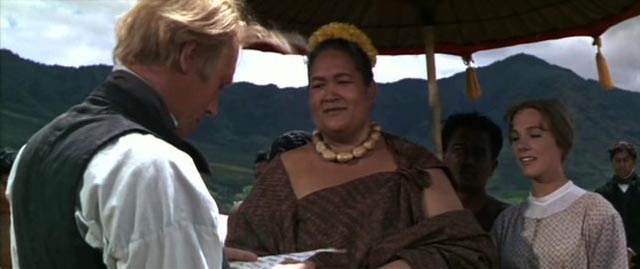
Even with the epic scale, spanning decades, and Russell Harlan’s lush, expansive Panavision photography, Hill manages to keep the focus closely on the characters, giving Hawaii a greater sense of intimacy than is usual for this type of production. The script is intelligent, the cast excellent, with von Sydow bringing the intensity of his work for Bergman and Troell to the largely unsympathetic central role of Hale, and Julie Andrews holding her own against him in what was only her second serious dramatic performance (following Hitchcock’s Torn Curtain earlier the same year). Gene Hackman appears in his first major role as Dr. John Whipple, a medical missionary who gradually moves away from Hale’s rigidity and towards some kind of integration with the local society; Richard Harris as Captain Rafer Hoxworth, who had formerly courted Jerusha before leaving on a three-year whaling voyage, is filled with bitter resentment when he finds her here in Hawaii married to the rigid Hale. Manu Topou, Ted Nobriga, Carroll O’Connor, Torin Thatcher, Michael Constantine and others give strong support.
But the real standout is Jocelyne LaGarde as Malama Kanakoa, a force of nature brimming with life and good humour in her sole acting role (for which she received an Oscar nomination). It is through her that the full cost of western colonial oppression is illuminated; the scene in which she renounces her beloved brother/husband Kelolo in order to be accepted by Hale’s God is heartbreaking; the revelation that this gesture, although made publicly to please Hale and his God, was not entirely sincere as she still clung to her love for Kelolo and the traditions it was based on, offers a glimmer of hope that traces of the original Hawaiian culture might yet survive.
Twilight Time’s Blu-ray contains two versions of the film. The 161-minute theatrical cut is presented in vibrantly colourful high definition, while the longer roadshow version (189 minutes) is unfortunately in standard definition. This is a pity because the longer version is a richer film, the extra minutes adding details and texture and nuance to the story.
*
I still have a few more Twilight Time disks to get to, and I’m looking forward to them as I’m seldom disappointed by the company’s releases. And I’d like to suggest a few possibilities for future disks from these three directors:
Mike Hodges: Croupier (1998), almost as good as Get Carter.
Michael Winner: In the commentary on an earlier disk it was mentioned that TT is planning to release Winner’s first western, Lawman (1971), but what about The Jokers (1967), his second collaboration with Oliver Reed, and The Nightcomers (also 1971)?
George Roy Hill: I’d love to see a Blu-ray edition of The Great Waldo Pepper (1975); my favourite among his films and seriously underrated, it has the best flying sequences since The Blue Max and one of the best scripts William Goldman ever wrote (based on Hill’s own story).
Comments
I just recently watched this great movie and reviewed it at my site. Your review of Chato’s Land is one of the best I’ve seen. I enjoyed reading it. Regards from Ruthless Reviews, where we really love Charles Bronson.